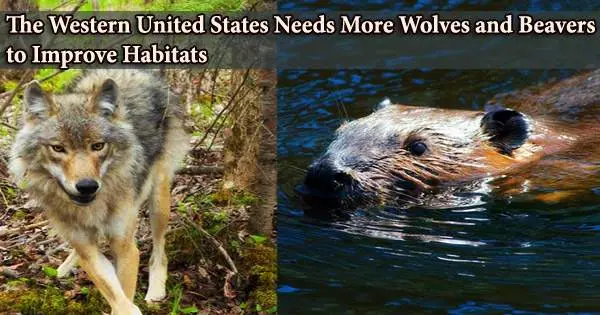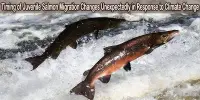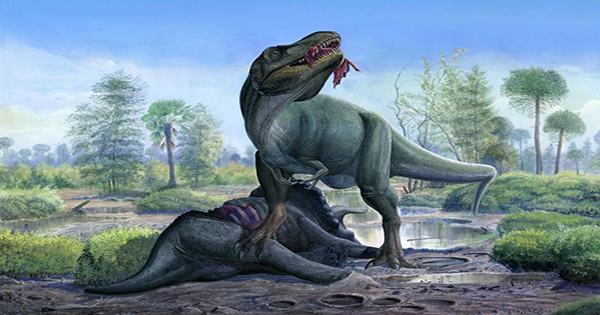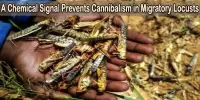On western federal lands, experts from Oregon State University are recommending management measures that, in their opinion, will increase the number of wolves and beavers and restore biological processes.
William Ripple, the co-lead author of the paper “Rewilding the American West,” and 19 other authors propose using a network based on prospective habitat for the gray wolf, an apex predator capable of causing strong, broad ecological effects, on areas of federal properties in 11 states.
The authors found areas of federally managed property in those states that are contiguous and are at least 5,000 square kilometers large and have ideal wolf habitat. The proposed Western Rewilding Network includes the following states: Oregon, Washington, California, Nevada, Idaho, Montana, Wyoming, Colorado, Arizona, New Mexico, and Utah. It would span an area of almost 500,000 square kilometers.
“It’s an ambitious idea, but the American West is going through an unprecedented period of converging crises including extended drought and water scarcity, extreme heat waves, massive fires and loss of biodiversity,” said Ripple, distinguished professor of ecology in the OSU College of Forestry.
Gray wolves were hunted to almost extinction in the West, but beginning in the 1990s, the Endangered Species Act made it possible to restore them to certain areas of the northern Rocky Mountains and the Southwest.
“Still, the gray wolf’s current range in those 11 states is only about 14% of its historical range,” said co-lead author Christopher Wolf, a postdoctoral scholar in the College of Forestry. “They probably once numbered in the tens of thousands, but today there might only be 3,500 wolves across the entire West.”
The authors claim that because beaver populations in many streams have completely disappeared after a 90% drop following settler colonialism, environmental services are not being given.
We suggest the removal of grazing on federal allotments from approximately 285,000 square kilometers within the rewilding network, representing 29% of the total 985,000 square kilometers of federal lands in the 11 western states that are annually grazed. That means we need an economically and socially just federal compensation program for those who give up their grazing permits. Rewilding will be most effective when participation concerns for all stakeholders are considered, including Indigenous people and their governments.
Professor Robert Beschta
Beavers enhance fish habitat, boost water and sediment retention, maintain water flows during droughts, improve water quality, promote carbon sequestration, and overall improve habitat for riparian plant and animal species by cutting down trees and bushes and building dams.
“Beaver restoration is a cost-effective way to repair degraded riparian areas,” said co-author Robert Beschta, professor emeritus in the OSU College of Forestry. “Riparian areas occupy less than 2% of the land in the West but provide habitat for up to 70% of wildlife species.”
Similarly, the authors claim that wolf restoration provides important ecological advantages by aiding in the natural management of native ungulates like elk. According to them, wolves help vegetation species like aspen, which supports a variety of plant and animal populations and is in decline in the West, to recover.
In the study, 92 threatened and endangered plant and animal species are listed, along with an analysis of the hazards posed by human activities to each species. At least 10% of these species’ ranges are located within the planned Western Rewilding Network.
The authors came to the conclusion that livestock grazing was the most frequent hazard. According to the authors, livestock grazing can degrade streams and wetland habitats, alter fire patterns, and hinder the ability of woody species, particularly willow, to rebound.
Federal grazing permits contribute to around 2% of the nation’s beef production, the paper notes.
“We suggest the removal of grazing on federal allotments from approximately 285,000 square kilometers within the rewilding network, representing 29% of the total 985,000 square kilometers of federal lands in the 11 western states that are annually grazed,” Beschta said.
“That means we need an economically and socially just federal compensation program for those who give up their grazing permits. Rewilding will be most effective when participation concerns for all stakeholders are considered, including Indigenous people and their governments.”
In addition to Beschta, Wolf and Ripple, authors from Oregon State include J. Boone Kauffman, Beverly Law and Michael Paul Nelson. Daniel Ashe, former director of the U.S. Fish and Wildlife Service and now the president of the Association of Zoos and Aquariums, is also a co-author.
The paper also included authors from the University of Washington, the University of Colorado, the Ohio State University, Virginia Tech, Michigan Technological University, the University of Victoria, the Turner Endangered Species Fund, the National Parks and Conservation Association, RESOLVE, the Florida Institute for Conservation Science, Public Lands Media and Wild Heritage.
















